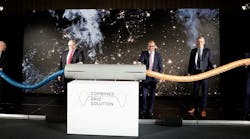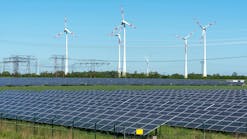50Hertz and the Danish system operator, Energinet, on Oct. 20 inaugurated a hybrid offshore interconnector, integrating German and Danish offshore wind farms.
The Combined Grid Solution (CGS) connects two offshore substations in the Baltic Sea to each other as well as to the existing onshore connections of the offshore wind farms. As a result, the CGS can bring offshore wind power to Denmark or Germany, as well as be used for cross-border energy trading.
The CGS consists of both hardware and software components. The Master Controller for Interconnector Operation, or MIO, which was developed with partners, acts as the “brain” of the system. This digital control unit, located in 50Hertz’ Control Center in Neuenhagen near Berlin, functions to harmonize both the requirements of the electricity market and the generation of electricity that depends on the wind conditions on the Baltic Sea.
The MIO’s most important task is the optimal exploitation of the interconnector and simultaneously ensuring the prevention of an overload of the line as well as the operating facilities in the substation. In this process, the MIO controls the market-based exchange of electricity between Denmark and Germany, not only on the basis of forecasts, but by ensuring the necessary voltage stability and system balance in case of physical deviations in real time. For this, the MIO can rely on the double converter in Bentwisch as well as on the German wind farms Baltic 1 and Baltic 2, and in the future also on the Danish Kriegers Flak wind farm, which will be connected and in action by then.
The double converter also fulfills an important function for grid stability, so that more and more renewable energies can be safely integrated into the overall system. For the transmission of electricity through alternating current lines, a so-called reactive power is required to co-exist with the active power. Until now, this reactive power was mainly provided by conventional power plants. The double converter is able to provide a section of the needed reactive power compensation for the north-eastern part of the 50Hertz grid area.
During the official inauguration ceremony, which took place on site in Berlin as well as online, Peter Altmaier, the German Federal Minister for Economic Affairs, called the CGS a “European lighthouse project for cross-border cooperation in the field of offshore wind energy."
The grid connections of wind farms Baltic 1 and Baltic 2 (Germany), which are operated by 50Hertz, as well as the grid connection to wind farm Kriegers Flak (Denmark), that is currently under construction, are also used as an interconnector. Two submarine cables of only 25 km in length with a capacity of 200 MW each, laid between the offshore substations of Baltic 2 and Kriegers Flak, bring both grid connection systems together.
Stefan Kapferer, CEO of 50Hertz, said: "With this project, 50Hertz and Energinet are pioneering the efficient integration of offshore wind farms into the cross-border European electricity market. It offers us several effective options to balance the frequency and voltage of our transmission grids at all times, to deal with the integration of renewable energy sources with more flexibility and to increase the stability of the overall system. Therefore the CGS is an essential puzzle piece of our strategy to cover 100 percent of the electricity demand in our grid area, over the course of a year, with renewable energy by 2032. In addition, the project shows the high significance of the European Baltic area for the energy sector. This importance is also reflected in the Baltic Sea Offshore Wind Declaration, which was signed by the [neighboring] states in late September."
As the transmission grids of eastern Denmark and Germany are not synchronous, the construction of a double converter at the Bentwisch substation near Rostock was necessary for this interconnector. Through the converter, the arriving alternating current (AC) is converted into direct current (DC) and immediately into alternating current again. This procedure is the only possibility to ensure a smooth flow of electricity from Denmark to Germany and vice versa.
Once the integrated Kriegers Flak wind farm has been commissioned in 2021 as planned, it will provide power supply to 600,000 households in the Zealand region. It has a capacity of 600 MW and will be Denmark’s largest wind farm.
Thomas Egebo, CEO of Energinet, said: "The Combined Grid Solution is not only a very important milestone in reaching Denmark’s ambitious goal of a 100 percent green power system in 2030. The groundbreaking project also delivers an important building block for decarbonizing the rest of the society. Wind and PV must in the near future replace petrol in our cars, oil, coal and gas in our private and district heating. And power from wind and solar will in the long run be the main ingredient in production of green hydrogen, green gasses, jetfuels, for industry, shipping and aviation. Therefore, the Danish Parliament has decided to build energy islands in the Baltic Sea and the North Sea and surround them with large scale offshore wind farms. The innovative CGS-solution combines offshore wind and interconnectors and is a leading example for energy islands and an efficient and fast green transition."
Chris Peeters, CEO of Elia Group, said: “The hybrid technology increases the efficiency of your investment: when there is no wind, the cable can be used as an interconnector. In this way, the Combined Grid Solution project also links the flexibility of two energy markets and gives access to renewables at the lowest cost. This is of vital importance to energy-intensive industries."
50Hertz


